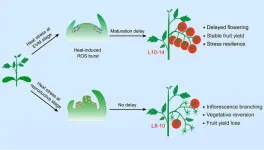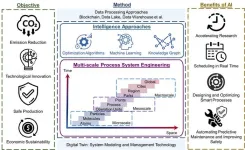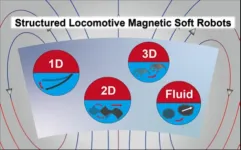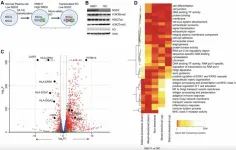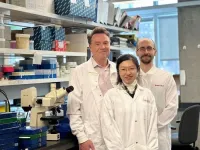(Press-News.org) A new study led by UNSW Sydney researchers into a cluster of stars 2700 light years away reveals their stages of evolution through the ‘sounds’ they make. This discovery will allow scientists to map the history of the Milky Way and other galaxies, accelerating knowledge in the field of astrophysics.
Dr Claudia Reyes is the lead author of the study published today in Nature. While undertaking her PhD at the UNSW School of Physics, she studied 27 stars in a cluster of stars called M67. The stars in this stellar cluster were all born from the same cloud of gas four billion years ago.
She says these stars have similar chemical compositions but different masses which made them ideal for studying evolution in real-time.
“When we study stars in a cluster, we can see their whole sequence of individual evolution,” Dr Reyes says.
She says while these stars are the same age, it’s their mass that gives away how quickly they’ve evolved. And, she adds, M67 is a very special cluster as it includes a broad range of ‘giants’, from the smaller, less evolved subgiants to red giants – the latter being the most evolved of stars.
The study also opens ways to learn more about what our own star – the Sun – will do as it becomes bigger and older. This is because, “the Sun was born in a cluster similar to the one we studied,” says Dr Reyes.
What’s the deal with clusters?
Observing such a broad evolutionary range of stars within a single cluster has never been achieved before at such detail.
“This is the first time we have really studied such a long range of evolutionary sequences, like we have in this cluster,” says coauthor Professor Dennis Stello, also from the UNSW School of Physics.
“Verifying the age of a star is one of the most difficult things to do in astronomy, because the age of a star isn't revealed by its surface,” Prof. Stello says.
“It is what happens inside that shows how old it is.”
Because the stars in the M67 cluster are of a similar age and composition to our Sun, they can offer insights into our solar system’s past and formation, as well as its future as the Sun evolves.
“Almost all stars are initially formed in clusters,” Prof. Stello says. “They are basically big families of hundreds to thousands of stars born from one big cloud of gas.
“Usually, they would slowly disperse into a diffuse random selection of stars.
“But some of them are still within groups – clusters. You can see them when you look to the sky as areas with lots of stars close together, where they are still closely bound, like the cluster we studied here.”
A symphony in the sky
The study allows for the precise determination of a star's age and mass based on its oscillation frequencies. The frequencies by which any star ‘rings’ depends on the physical properties of the matter inside of it, giving clues about its density, temperature and age.
This was the first time researchers could interrogate the ‘ringing’ across a cluster of stars to learn more about their interiors. They used the Kepler K2 mission as the primary way to observe, or ‘listen’.
Prof. Stello says the process is like listening to an orchestra, and identifying instruments based on their sound.
“The frequency by which an instrument is vibrating – or ringing – depends on the physical properties of the matter that the sound travels through,” he says.
“Stars are the same. You can ‘hear’ a star based on how it rings.
“We can see the vibration – or the effect of the vibration – of the sound just like you can see the vibration of a violin string.”
The biggest stars have the deepest sounds. Small stars have high-pitched sounds. And no one star plays just the one note at once – each star covers a symphony of sound coming from its interior.
In space, no one can hear you scream (or sing)
Sound exists as a wave of energy, a vibration, moving through particles – solid, liquid or gas. But in space, there are no particles, which means there’s no sound.
Prof. Stello says each star is like a breathing ball of gas – cooling down and heating up – with slight changes in brightness.
“It’s these fluctuations in brightness that we watched and measured, to gauge the sound frequencies,” he says.
As stars mature towards red giants, their frequencies change and behave differently. These changes can track their evolution.
The frequency differences between the many nodes ‘played’ by a star can give clues about a star’s interior properties.
By studying the 27 stars in the M67 open cluster, the researchers could, for the first time, observe the relationship between small and large frequency differences in giant stars, which can now be applied to individual stars.
Understanding the Milky Way
To better understand the formation and evolution of galaxies, scientists need to know the age of all its components, including the stars.
Dr Reyes says this study will lead to the accurate identification of the mass and age of stars in the Milky Way – something yet to be achieved.
This is also important for understanding stars that host planets, as a star’s properties are critical for supporting life on those worlds.
Prof. Stello says frequency signatures will also be important when modelling the future evolution of our own Sun.
“This study has enabled us to probe the fundamental physics that happens inside stars, deep into their interiors, and the fundamental physics under these extreme conditions,” he says.
“This is something we still grapple with. It's important for us to build evolution models that we can trust, so that we can predict what happens not only to the Sun, but also to other stars as they grow older.
"Seeing the evolutionary phase of stars directly through the fingerprint of frequencies is what enables us to be much more certain about the ‘ingredients’ we put into our models,” he says.
What’s in the future?
Dr Reyes says their findings were unexpected.
“We discovered something new with this signature in the frequencies,” she says.
Dr Reyes says we already have data from many years of studying the Milky Way and its stars.
“The next step is to go back and look at that data,” she says. “To look for these particular frequencies that nobody thought to look for before.
“And we can do this by listening to the stars.”
– ENDS –
END
Sound frequencies of stars sing of our galaxy’s past and future
2025-04-02
ELSE PRESS RELEASES FROM THIS DATE:
Tomato plants delay shoot meristem maturation to achieve heat-stress resilience
2025-04-02
As global temperatures continue to rise, extreme heatwaves pose a significant threat to agricultural productivity. Studies estimate that for every 1°C increase above pre-industrial levels, crop yields decline by approximately 6-8%. The ability of plants to withstand heat stress is therefore critical for ensuring food security, yet the underlying molecular mechanisms have largely remained elusive.
Now, however, a new study led by Prof. XU Cao's team at the Institute of Genetics and Developmental Biology (IGDB) of the Chinese Academy of Sciences sheds light on an adaptive strategy that may ...
KTU researchers explore using soil for heat storage
2025-04-02
When spring arrives and the heating season comes to an end, keeping warm becomes less of an issue. However, scientists remind us that it is not just a seasonal necessity – heat is also a valuable energy resource that can be stored and used when needed most. Researchers at Kaunas University of Technology (KTU) have discovered an innovative solution beneath our feet: using soil as an efficient thermal energy storage system.
KTU professor Dr Tadas Ždankus and his team have been investigating how the ground can serve not only for construction purposes but also as a medium for heat storage. At the ...
Sociology leaders rally in support of academia, urge protection of free inquiry and research
2025-04-02
The American Sociological Association has led a coalition of leading sociological organizations to issue an open letter defending the vital role of sociology in universities and society while condemning recent federal actions that threaten academic inquiry and free speech. Signed by the presidents of ten major sociological associations, the letter calls on university leaders, policymakers, and the public to resist efforts that undermine the discipline and stifle research that benefits society.
The signatories express their growing concerns over abruptly canceled federal contracts, looming job losses for sociologists ...
Exploring AI’s role in decarbonizing the chemical industry: A multi-scale perspective
2025-04-02
As the chemical industry seeks sustainable transformation, decarbonization requires intelligent solutions across multiple scales to enhance efficiency and reduce emissions. A research team led by Professor Xiaonan Wang at Tsinghua University has systematically reviewed AI-driven multi-scale smart systems for decarbonizing this energy-intensive sector. Published in Technology Review for Carbon Neutrality, the study explores innovations from materials discovery to industrial park optimization, highlighting ...
A review on structured magnetic soft robots: Locomotion innovation driven by structural engineering
2025-04-02
Recently, Dr. Renheng Bo, Research Associate Professor at the State Key Laboratory of Flexible Electronics Technology, Tsinghua University, and his colleagues published a new review article entitled "Structured Locomotive Magnetic Soft Robots" in Flextech. This article focuses on the relationship between structural configurations and locomotion modes of magnetic soft robots, which systematically summarizes the material compositions, fabrication methods, locomotion mechanisms, and applications of existing magnetic soft robots. Furthermore, it emphasizes current challenges and future research directions in the field of structured ...
NCCN 2025 Annual Conference illustrates the critical impact of cancer research on improving lives
2025-04-02
ORLANDO, FL [April 2, 2025] — The National Comprehensive Cancer Network® (NCCN®)—an alliance of leading cancer centers—celebrated 30 years of helping people with cancer to live better lives during the NCCN 2025 Annual Conference, March 28-30 in Orlando, Florida. The yearly event brings together leading minds and subject matter experts in front of a multidisciplinary audience to share the latest recommendations for cancer treatment and prevention.
“We are proud to honor our founders’ vision of sharing evidence-based, expert consensus-driven recommendations through clinical practice guidelines to improve ...
NSD2 gene drives cancer cell identity in multiple myeloma
2025-04-02
“Our findings suggest a role for NSD2 in maintaining MM cell identity, with potential implications for future therapeutic strategies based on targeting of NSD2.”
BUFFALO, NY – April 2, 2025 – A new research paper was published in Oncotarget, Volume 16, on March 21, 2025, titled “NSD2-epigenomic reprogramming and maintenance of plasma cell phenotype in t(4;14) myeloma.”
Researchers Andrea Gunnell, Scott T. Kimber, Richard Houlston, and Martin Kaiser from The Institute of Cancer Research, London, studied how a gene called ...
From octopus intelligence to smart artificial blood vessels: 2025 Schmidt Science Fellows to break new ground with interdisciplinary research
2025-04-02
NEW YORK—Thirty-two early career researchers, tackling issues from improving food security to developing better medical implants, were awarded up to two years of grant funding to pursue innovative interdisciplinary science, Schmidt Science Fellows announced today.
Now in its eighth year, the fellowship, a program of Schmidt Sciences, provides financial support for a postdoctoral placement of one to two years at a world-class research institution. The funding equips scientists to apply their knowledge to a new field of study with the goal ...
Experts challenge aspirin guidelines based on their undue reliance on a flawed trial
2025-04-02
Recent guidelines have restricted aspirin use in the primary prevention of cardiovascular disease. The American Heart Association (AHA)/American College of Cardiology (ACC) guidelines restricted aspirin to patients under 70, and more recently, the United States Preventive Services Task Force restricted aspirin use to patients under 60. However, heart attack and stroke risks both rise with age, leaving health care providers unsure about when to stop prescribing aspirin, whether it should be used for primary prevention, and which patients would benefit most.
Researchers from Florida Atlantic University’s ...
McGill discovery sheds new light on autism, intellectual disabilities
2025-04-02
A new study by McGill University researchers yields insights into how the disruption of calcium transport in the brain is linked to autism and intellectual disability. The findings, published in the journal Nature, not only upend a long-held belief among neuroscientists, but could pave the way for treatments.
The researchers discovered that tiny protein structures on brain cells, known as AMPA receptors, can transport calcium. While previous research had suggested that disruptions in calcium ...
